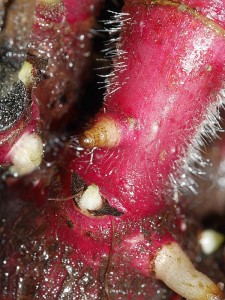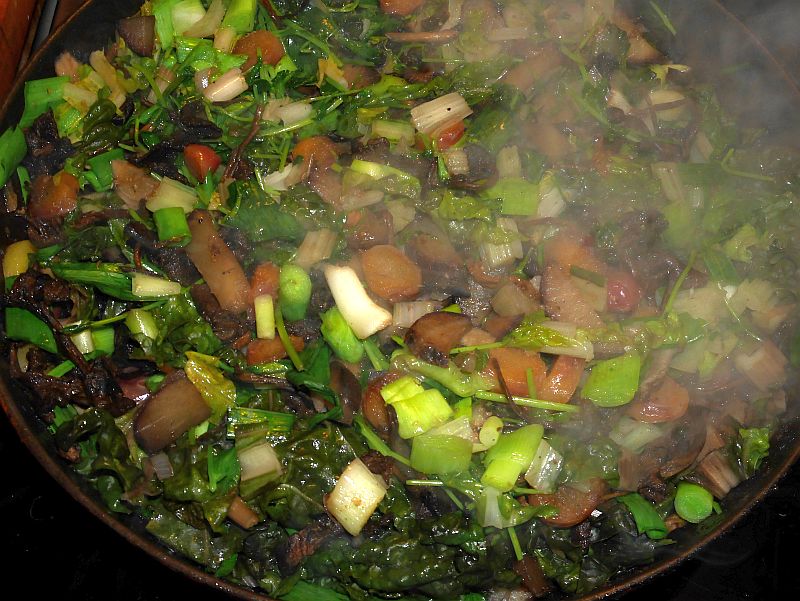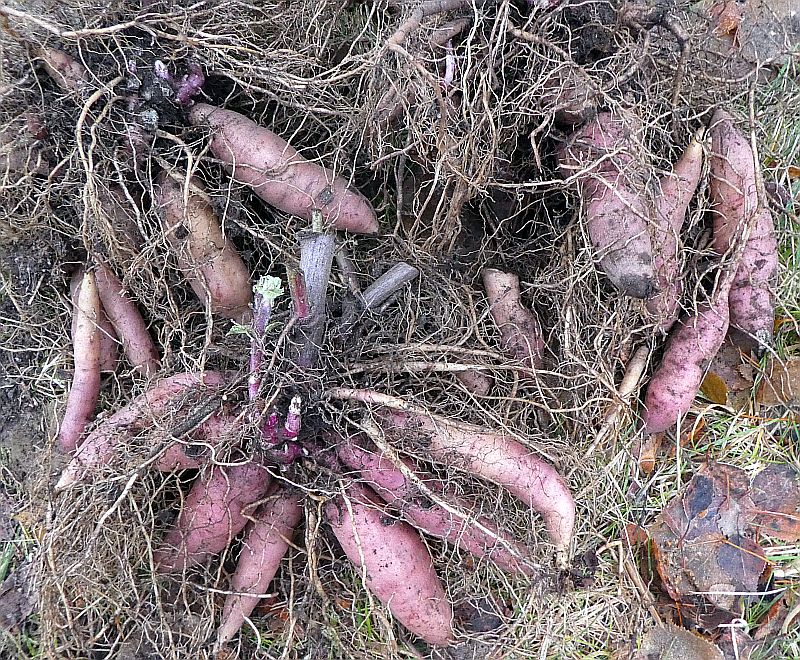When giving talks I like to renew myself and talk about something different each time. For my talk in Copenhagen at the Future Heirloom event last weekend I focussed during part of my presentation on edimentals in the Asteraceae or Compositae (the aster or daisy family / kurvplantefamilien). These are tbe edible perennial vegetables that are most obvious in the autumn garden and often underutilised by chefs in the west. Visiting the World Garden a few days before my talk on 17th October, I gathered flowers from all the flowering Asteraceae and here they are with names: Most are used for their tasty spring shoots and leaves, used cooked and raw, and most have a characteristic fragrant taste / aroma loved in the Far East (as also Chrysanthemum tea is popular and a refreshing accompaniment to spicy dishes). Aster scaber and Ligularia fischeri are nowadays both cultivated in a big way as “sannamul” in Korea and even exported to Korean markets around the world. Young shoots of other Aster sp. are foraged in Asia as is big-leaf Aster, Aster macrophyllus, in North America. Also from North America, cutleaf coneflower Rudbeckia laciniata or sochan was a popular vegetable for the Cherokee first people and in recent years has, maybe not unsurprisingly become a commercial vegetable in Korea. Annual shungiku or chopsuey greens Glebionis coronaria hails from the Mediterranean but is today an important vegetable in the Far East! Others currently in flower are best known as root crops, including (in the picture) Jerusalem artichoke (Helianthus tuberosus) and Dahlia. Yacon (Polymnia sonchifolia) is also autumn flowering but doesn’t manage to flower here (is moved indoors to flower and bulk up). The final flower in the picture is marigold Calendula officinalis, whose culinary use includes decorating and flavouring salads, soups and other dishes.
Most are used for their tasty spring shoots and leaves, used cooked and raw, and most have a characteristic fragrant taste / aroma loved in the Far East (as also Chrysanthemum tea is popular and a refreshing accompaniment to spicy dishes). Aster scaber and Ligularia fischeri are nowadays both cultivated in a big way as “sannamul” in Korea and even exported to Korean markets around the world. Young shoots of other Aster sp. are foraged in Asia as is big-leaf Aster, Aster macrophyllus, in North America. Also from North America, cutleaf coneflower Rudbeckia laciniata or sochan was a popular vegetable for the Cherokee first people and in recent years has, maybe not unsurprisingly become a commercial vegetable in Korea. Annual shungiku or chopsuey greens Glebionis coronaria hails from the Mediterranean but is today an important vegetable in the Far East! Others currently in flower are best known as root crops, including (in the picture) Jerusalem artichoke (Helianthus tuberosus) and Dahlia. Yacon (Polymnia sonchifolia) is also autumn flowering but doesn’t manage to flower here (is moved indoors to flower and bulk up). The final flower in the picture is marigold Calendula officinalis, whose culinary use includes decorating and flavouring salads, soups and other dishes.
Late flowering also means that the Asteraceae are also particularly important for a range of insect pollinators like hoverflies, drone flies and bees as can be seen in the pictures below, all taken in the World Garden:
Tag Archives: Yacon
Rhizo-bacalhau
We occasionally eat wild fish and bacalhau is a favourite made from Norwegian dried cod that can be found in supermarkets here. More or less anything goes in bacalhau (bacalao) and although most people make it in the same way – layers of potato, fish, tomato and onions, often with chili – the Portuguese have hundreds of ways of preparing baccalao (dried cod). Being self-sufficient, detailed recipes aren¨’t useful and we use whatever is available at the moment. Winter is the time for stored bulbs, corms, tubers, rhizomes, and taproots. See below the picture for yesterday’s baccalao ingredients with 14 home grown below surface storage organs plus some greens (I’m pretty sure nobody else had this version of the dish…ever!):
Oca (Oxalis tuberosa): yellow and red varieties
Garlic / hvitløk (Allium sativum)
Wapato (Sagittaria latifolia)
Potato / potet (Solanum tuberosum) – 2 varieties
Jerusalem artichokes / jordskokk (Helianthus tuberosus)
Parsnip / pastinakk (Pastinaca sativa)
Scorzonera / scorsonerrot (Scorzonera hispanica)
Common onion / kepaløk (Allium cepa)
Cacomitl (Tigridia pavonia)
Yacon (Polymnia sonchifolia)
Burdock / storborre (Arctium lappa)
Madeira vine (Anredera cordifolia)
Parsnip / pastinakk (Pastinaca sativa) shoots – had started shooting in the cellar
Leaf beets / bladbete (Beta vulgaris var. flavescens) – 3 varieties
Allium nutans (forced in the living room)
plus (not home grown) organic tomatoes, olive oil and olives
(I forgot the dandelion…will add tonight: we make enough that it lasts for several days….and the taste improves!)
Xmas diversity from the rhizosphere
Presenting this year’s 30 rhizosphantastic Xmas vegetables, all roasted in the oven, served as every year in the last 40 with nut roast, bedecked with the following seeds / bulbils: alpine bistort / harerug (Polygonum viviparum), Himalayan balsam / kjempefringfrø (Impatiens glandulifera), evening primrose / nattlys (Oenothera biennis) and opium poppy (Papaver somniferum). The tubers are listed below the pictures.



The 30 tubers, roots and rhizomes in the picture are:
Solanum tuberosum (potato / potet: 11 varieties)
Daucus carota (carrot / gulrot)
Oxalis tuberosa (oca: 2 varieties)
Arctium lappa (burdock)
Scorzonera hispanica (Scorzonera / scorsonnerot eller svartrot)
Tigridia pavonia (cacomitl)
Pastinaca sativa (parsnip / pastinakk)
Beta vulgaris (beetroot / rødbete)
Tropaeolum tuberosum (mashua)
Anredera cordifolia (Madeira vine)
Helianthus tuberosus (Jerusalem artichoke / jordskokk : 3 varieties)
Brassica rapa (turnip / nepe)
Brassica napus (swede / kålrot)
Dahlia (Dahlia / georginer)
Polymnia sonchifolia (yacon)
Sagittaria latifolia (wapato)
Allium cepa (onion)
Winter stir-fry
People are always asking me for recipes. I rarely follow recipes as my ingredients vary so much and I just use what I have available. However, I do follow a number of basic, mostly lacto-vegetarian recipes which I’ve evolved to my liking over the years. For instance, last night I used
a) Pea shoots (erteskudd), harvested about 25cm high (before they get too coarse to use; I don’t cut them right down to the soil as they will then resprout once or twice before giving up; to do this, they must be grown in a bucket or similar in deep soil); the peas were a mixture of about twenty home grown varieties, including several heirlooms such as Norwegian Jærert and Ringeriksert).
b) Swiss chard / mangold (it’s been too cold for this to regrow in the cellar where it’s planted in soil)
c) Chicory “Catalogna gigante di Chioggia” (sikkori) (this had resprouted in the cellar from the roots)
d) Leeks / purre (also stored in soil in the cellar)
e) Yacon (sliced tubers)
f) Scorzonera / scorsonnerot (sliced tubers)
g) Oca (oka) (Oxalis tuberosa)
h) Garlic / hvitløk
i) Chili / chili
j) Bulb onions / kepaløk
k) golpar (ground seed of various Heracleum species; bjørnekjeks / Tromsøpalme)
The roots are stir-fried first (in olive oil), then the onions are added and at the end the greens for 5-10 minutes, finally mixing in chili, salt and pepper. Served either over whole grain spelt pasta or mixed as a risotto (I use barley normally for a barlotto) with strong cheese or parmesan.
The roots are stir-fried first (in olive oil), then the onions are added and at the end the greens for 5-10 minutes, finally mixing in chili, salt and pepper. Served either over whole grain spelt pasta or mixed as a risotto with strong cheese or parmesan.
Last or First?
A few days ago I harvested my yacon (Polymnia edulis). My season outside is a bit too short to get good yields outside, so I grow in large pots which I move in to the living room in autumn and grow on for 2-3 months. This year I was a bit late and one of the plants had been cut right down by an early frost and the other was badly damaged. Both sent up new shoots when they came into the house.
The first harvest of 2021 or the last of 2020?

Yacon and Madeira Vine flowering outside
To my surprise, I noticed today that both yacon (Polymnia sonchifolia) and Madeira Vine (Anredera cordifolia) have managed to flower outside in the garden before I bring them inside for the winter just before the first frost. I’m surprised as the autumn has been colder than normal…maybe this is rather a consequence of the record warmth in June.


Yacon and sunchoke harvest
Jack-on

Tonight’s barlotto



..and end of the year Yacon harvest
The sweet tasting tubers are becoming quite popular in recent years! Yacon is in the Asteraceae, the roots containing inulin like its edible tubered cousins Jerusalem artichoke and Dahlia.


































